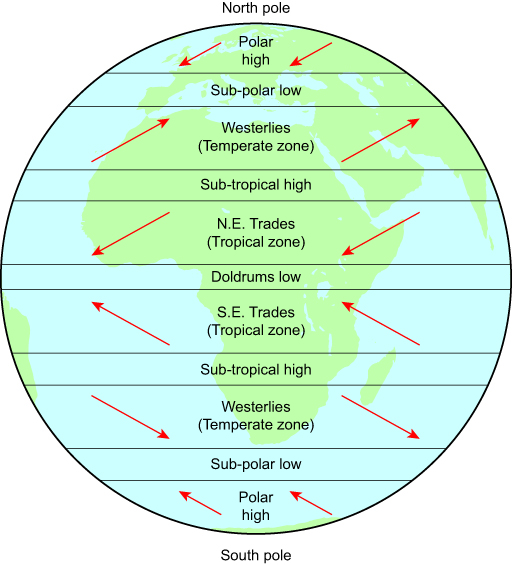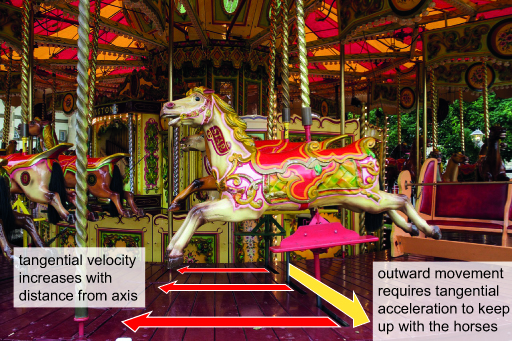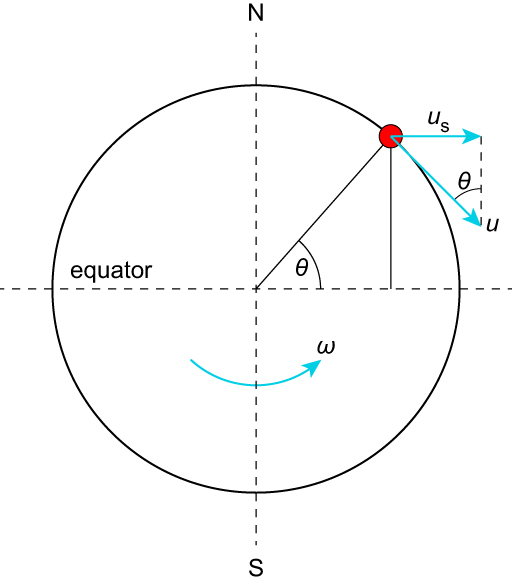1.2 Upper-atmosphere winds and air movements
Although the upper atmosphere is directly first in line with radiation arriving from the Sun, the mechanism by which it is heated is less direct. A good deal of the solar radiation passes through the atmosphere and warms up the more massive and dense land masses and oceans below. These absorb and retain heat energy which is then re-radiated at infrared wavelengths that do not pass so easily through the air as the incoming radiation. This is not a uniform process, however.
The oceans have a temperature variation which is less (i.e. more steady) than that of land masses, and the clouds reflect heat back and forth in a varying manner. Combine these effects with the daily rotation of the Earth causing heat cycles and the longer heat cycles due to the seasons caused by the Earth’s axis being tilted (obliquity) as it orbits the Sun, and all of this adds up to a highly complex pattern of temperature variations in the atmosphere. It is the temperature variation which causes changes in density and pressure, which in turn cause air movements and winds that affect weather patterns.
Trade winds
Winds may be considered in two groups. First are the more regular settled patterns on a global scale as shown in Figure 3. This represents an overall sustained pattern of regular winds which were important in the days of sailing ships, assisting their sojourns around the world delivering and collecting goods. The term trade winds, which originally referred to the old English expression of ‘tracking winds’, became associated with this commercial context. These and other steady winds arise because of the uneven but regular heating of the Earth. Near the equator where the Sun’s radiant heat is most powerful, the air is heated, expands, reduces in density and rises. In rising, especially over the ocean, it cools, and water vapour condenses, giving up latent heat. This sustains the upwards motion which spills outwards North and South away from the tropics.
Meanwhile cooler higher-pressure air moves towards the equatorial region because of the now lower-pressure there. These movements are deflected laterally, however, due to the Coriolis effect of the Earth’s rotation to form the trade winds. The green box on the Coriolis acceleration outlines how this effect arises. A similar situation arises near the poles of the Earth, where the colder higher-pressure air is induced to flow away from the poles towards the lower-pressure air in the temperate zones. Again the Coriolis effect deflects these to form the so called westerlies in both hemispheres.
Coriolis accelerations
Any object moving on a straight path north of the equator appears to an observer on the ground to be deflected to the right. Conversely, any object moving on a straight path south of the equator appears to be deflected to the left.
This apparent deflection, resulting from movement towards or away from an axis of rotation, is a manifestation of the Coriolis acceleration or the Coriolis effect, named after Gaspard-Gustave de Coriolis (1792–1843) who pioneered the study of rotating frames of reference.
The Coriolis acceleration
The Coriolis acceleration arises in any situations when an object or body travels towards or away from the axis of a rotating frame of reference. The combination of rotation and distance from the axis results in a linear velocity, so if the distance changes the velocity also changes and the result is an acceleration at right angles to both the direction of travel and the axis of rotation. This is the Coriolis acceleration, denoted by .
For a simple visualisation, imagine a fairground worker walking outwards along a radius of a rotating roundabout in order to get tickets (Figure 4). Although everything on the platform is rotating at the same angular velocity about the central vertical axis, the horses further away from the centre have a higher linear velocity relative to the stationary ground. Thus, a worker moving radially outwards on the platform will need to accelerate to keep up with the horses. Equally if travelling radially inwards towards the axis of rotation the worker will need to decelerate in order to match the lower velocities of the inner horses.
Figure 5 summarises the situation for different combinations of inward or outward movement and clockwise or anticlockwise rotation. The component of velocity towards or away from the axis, , is itself rotating about a vertical axis through O. Note the directions of , the rotating reference angular velocity, , and the resulting acceleration .
The magnitude of the Coriolis acceleration experienced by the body is given by the simple equation:
Figure 6 shows an idealised picture of the Earth viewed from far above the equator. Neglecting the tilt angle (obliquity), the Earth rotates from west to east about the imaginary vertical axis joining the North and South Poles. The angular velocity of rotation, , is of course one revolution or 2π radians per full day (24 hours). (It actually takes the Earth 23 hours, 56 minutes and 4 seconds to make a full 360° rotation. The other 3 minutes and 56 seconds is needed to account for the Earth’s rotation round the sun and can be ignored for most engineering purposes.)
Consider an object or element of something moving on or near the Earth’s surface directly from north to south, shown red in Figure 6. The something could be a chunk of sea, air, a ship, artillery shell, etc.
The object has a velocity and is at a latitude angle of , so the component of velocity parallel to the axis of rotation is and the component of velocity perpendicular to the axis of rotation is . The Coriolis acceleration
where
therefore
The same formula applies to travel east or west: in these cases the full Coriolis acceleration of is directed outwards from the axis and the component tangential to the surface is . Since it applies to both north–south and east–west movement, Equation 7 can be applied to any movement on the surface of the earth.
The Coriolis effect on an Earth scale
What is the Coriolis acceleration experienced by a body on the surface of the Earth in terms of its latitude, and its velocity ? Give your answer to 3 significant figures.
Solution
As the earth makes a full rotation (2π radians) every 24 hours, a rotating reference frame moving with it will have an angular velocity given by
Using equation (8), an object travelling with a velocity will be subject to a Coriolis acceleration of
This is obviously very small compared to , but in weather systems and tidal currents over many hours or even days, these accelerations can result in major weather effects. Alternatively, if the value of is very high, such as in artillery shells or missiles, the effect has to be allowed for in setting aim coordinates. (This is how Coriolis came into the picture.)
Activity 6
Determine the Coriolis acceleration and the accompanying lateral accelerating force on a cubic metre of air at ground level if the wind speed north to south is 80.0 km h−1 at a latitude of 60.0°. Use as the standard sea-level value of 1.225 kg m−3. Give your answer to 3 significant figures.
Answer
The wind speed is
The angular velocity of the Earth is
At 60 degrees the effective radial velocity is
So the Coriolis acceleration is
The Coriolis force is found from therefore
Cyclones and anticyclones
The second group of winds comprises the more adhoc erratic fluctuations which can turn into vortices thousands of kilometres across that last for a limited period, usually measured in days. These are the cyclones and anticyclones mentioned in weather reports. A cyclone is often referred to as a depression or a low because it centres on a region of low pressure. The low pressure will be at most around 10 or 12 per cent below standard atmospheric pressure, but on the scale of a cyclone even a drop that small can provoke huge air movements. The air begins to move radially inwards towards the low pressure, and is then deflected by the Coriolis effect as the Earth rotates.
In the northern hemisphere the Coriolis effect will tend to move the airflow direction clockwise away from the centre, as shown in Figure 7. In this figure the airflow was heading towards the central low pressure, but was then deflected away from it to an extent by the Coriolis effect. The pressure gradient inwards can counteract or overcome this tendency of deflection to the point that an equilibrium flow is set up with just enough inward force remaining to provide the centripetal acceleration for overall circular flow to develop in an anticlockwise direction, as shown in Figure 7. (In the southern hemisphere the overall flow direction is clockwise.)
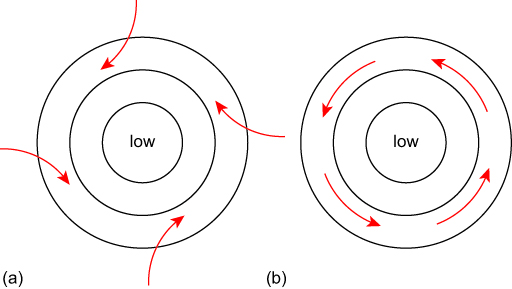
An anticyclone is often referred to as a high because it centres on a region of high pressure. The high pressure will be at most only around 5 or 6 per cent above standard atmospheric pressure with lower pressure gradients than for cyclones, leading to steadier and more gentle air movements. The air begins to move radially outwards towards the surrounding lower-pressure regions. As with cyclones, the air is then deflected by the Coriolis effect as the Earth rotates, this time inducing an overall flow direction clockwise in the northern hemisphere. Figure 8 shows the idea. (In the southern hemisphere the overall flow direction is anticlockwise.)
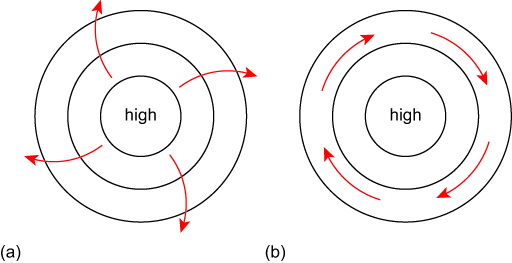
Generally speaking, because of the lower pressure differences compared with cyclones, anticyclones invoke fewer clouds and lighter winds. In the summer this can lead to extensive exposure to sunlight and rising warm air from which moisture can condense into thunderclouds or to form morning mists. In the winter, more radiant heat escapes from the ground, leading to lower temperatures both night and day with fogs and frosts at night as well as ice and freezing temperatures. Cyclones, on the other hand, lead to cooler weather in summer due to cloudy and wet conditions, and slightly warmer winter days than with anticyclones but accompanied again by clouds and possibly snow, and importantly, strong winds, as they are driven by higher pressure differences than anticyclones.

